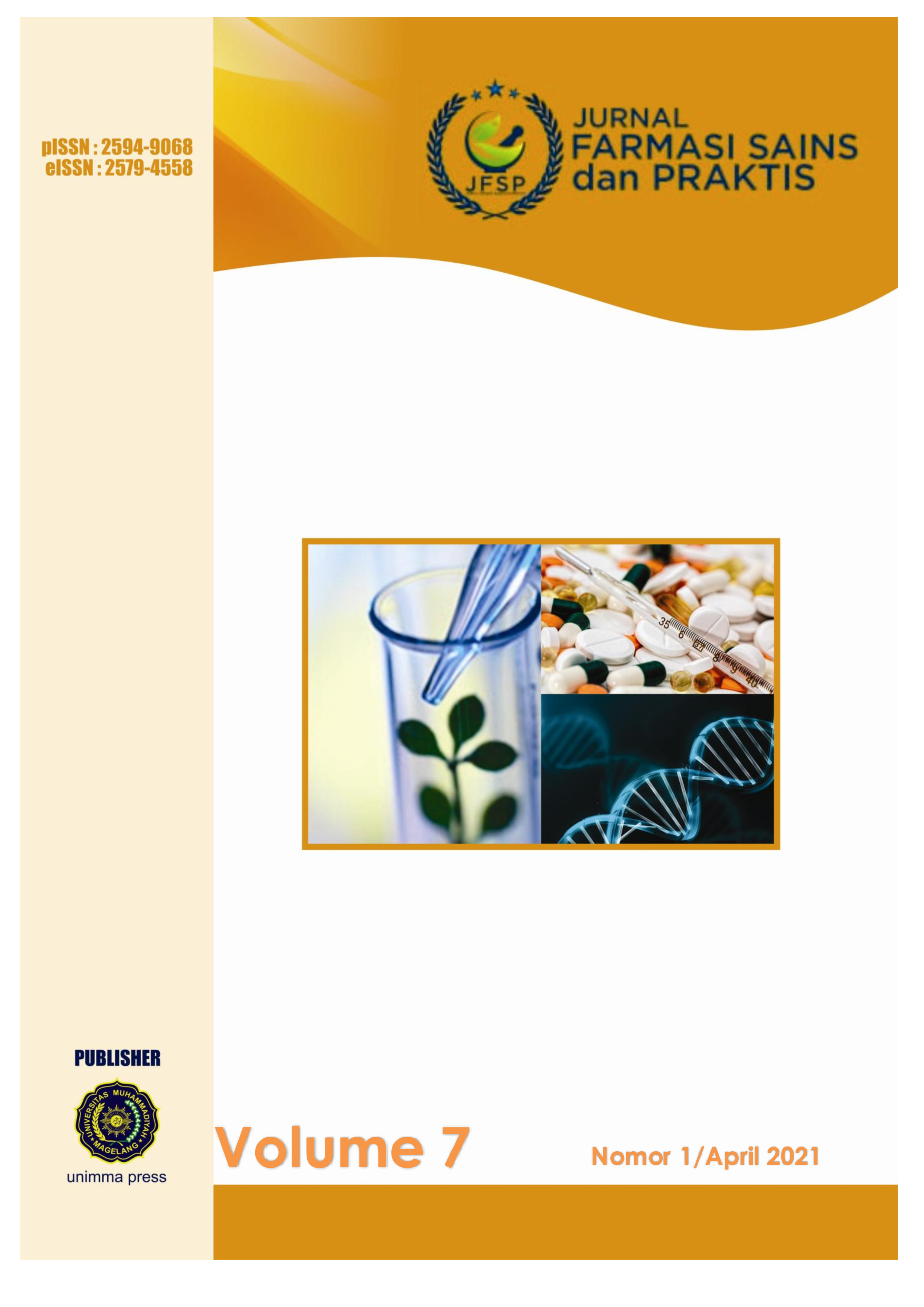Main Article Content
Abstract
One of the antidiabetic activity tests is carried out through inhibition testing of the ɑ-glucosidase enzyme. Sonneratia ovata Backer is a mangrove plant that has been used traditionally in medicine. The antidiabetic activity of the fruit samples of Kedabu (Sonneratia ovata Backer) was tested by measuring the inhibition of the ɑ-glucosidase enzyme in vitro. The test sample used ethanol extract (EE) and 3 fruit fractions of Kedabu. The calculation result of the IC50 value obtained at EE was 1.86 µg / mL, the calculation result of the IC50 value obtained in the n-hexane (FH) fraction of Kedabu fruit was 193.32 µg / mL, the calculation result of the IC50 value obtained in the ethyl acetate fraction (FE) of fruit Kedabu is 2.32 µg / mL and finally the calculation result of the IC50 value of water fraction (FA) is 2.29 µg / mL. The positive control in this study, Akarbose, obtained an IC50 result of 0.75 µg / mL. Based on the results obtained, the ethanol extract of Kedabu (Sonneratia ovata Backer) fruit is very active and has the potential as an inhibitor of the ɑ-glucosidase enzyme, followed by the water fraction and ethyl acetate fraction, while the potentially inactive sample is in the n-hexane fraction.
Keywords
Article Details

This work is licensed under a Creative Commons Attribution-NonCommercial 4.0 International License.
References
- Ahmed, R., Moushumi, S. J., Ahmed, H., Ali, M., Haq, W. M., Jahan, R., & Rahmatullah, M. (2010). Serum Glucose and Lipid Profiles in Rats Following Administration Of Sonneratia caseolaris (L.) Engl. (Sonneratiaceae) Leaf Powder in Diet. Advances in Natural and Applied Sciences, 4(2), 171–174.
- Armawan, A., Hanafi, M., Abbas, J., Dewi, R. T., Ernawati, T., Sugiwati, S., Taufik, R. (2010). Isolasi, Karakterisasi dan Elusidasi Senyawa Bioaktif Antidiabetes Dari Daun Cocor Bebek (Kalanchoe pinnata (Lam) Pers.). Serpong: Pusat Penelitian Kimia Lembaga Ilmu Pengetahuan Indonesia.
- Baynest, H. W. (2015). Classification, Pathophysiology, Diagnosis and Management of Diabetes Mellitus. Journal of Diabetes & Metabolism, 6(5), 1–9. https://doi.org/10.4172/2155-6156.1000541
- Chang, L., Li, C., Qin, N., Jin, M., & Duan, H. (2012). Synthesis and Antidiabetic Activity of 5, 7‐Dihydroxyflavonoids and Analogs. Chemistry & Biodiversity, 9(1), 162–169.
- Derosa, G., & Maffioli, P. (2012). α-Glucosidase inhibitors and their use in clinical practice. Archives of medical science: AMS, 8(5), 899.
- Elya, B., Handayani, R., Sauriasari, R., Hasyyati, U. S., Permana, I. T., & Permatasari, Y. I. (2015). Antidiabetic activity and phytochemical screening of extracts from Indonesian plants by inhibition of alpha amylase, alpha glucosidase and dipeptidyl peptidase IV. Pakistan Journal of Biological Sciences, 18(6), 279.
- Hermayudi, H., & Ariyani, A. P. (2017). Metabolik Endokrin. Yogyakarta: Nuha Medika.
- Jariyah, Widjanarko, S. B., Yunianta, & Estiasih, T. (2015). Hypoglycemic Effect of Pedada (Sonneratia caseolaris) Fruit Flour (PFF) in Alloxan-Induced Diabetic Rats. International Journal of PharmTech Research, 7(1), 31–40.
- Kumar, V., Kumar, S., & Rani, P. (2010). Pharmacophore Modeling and 3D-QSAR Studies on Flavonoids as α- Glucosidase Inhibitors. Der Pharma Chemica, 2(4), 324–335.
- Nair, S. S., Kavrekar, V., & Mishra, A. (2013). In vitro studies on alpha amylase and alpha glucosidase inhibitory activities of selected plant extracts. European Journal of Experimental Biology, 3(1), 128-132.
- Patel, D. K., Kumar, R., Laloo, D., & Hemalatha, S. (2012). Diabetes mellitus: an overview on its pharmacological aspects and reported medicinal plants having antidiabetic activity. Asian Pacific Journal of Tropical Biomedicine, 2(5), 411-420.
- Proença, C., Freitas, M., Ribeiro, D., Oliveira, E. F. T., Sousa, J. L. C., Tomé, S. M., Fernandes, E. (2017). α-Glucosidase Inhibition by Flavonoids: An In Vitro and In Silico Structure–Activity Relationship Study. Journal of Enzyme Inhibition and Medicinal Chemistry, 32(1), 1216–1228. https://doi.org/10.1080/14756366.2017.1368503
- Rosemary, Rosidah, & Haro, G. (2014). Antidiabetic Effect of Roselle Calyces Extract (Hibiscus sabdariffa L.) in Streptozotocin Induced Mice. International Journal of PharmTech Research, 6(5), 1703–1711.
- Singab, A. N., Youssef, F. S., & Ashour, M. L. (2014). Medicinal plants with potential antidiabetic activity and their assessment. Med Aromat Plants, 3(151), 2167-0412.
- Surya, S., Salam, A. D., Tomy, D. V., Carla, B., Kumar, R. A., & Sunil, C. (2014). Diabetes Mellitus and Medicinal Plants-A Review. Asian Pacific Journal of Tropical Disease, 4(5), 337–347. https://doi.org/10.1016/S2222-1808(14)60585-5
